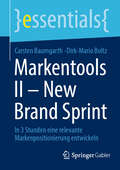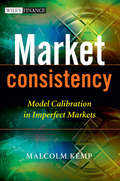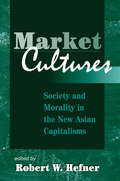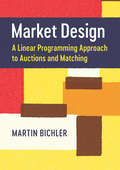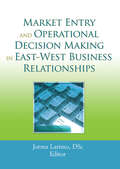- Table View
- List View
Markenorientierte digitale Transformation: Wie Sie Ihr Unternehmen erfolgreich in das digitale Zeitalter führen (essentials)
by Artur MertensDie digitale Transformation beschäftigt branchenübergreifend derzeit beinahe jedes Unternehmen, von der Automobilindustrie über Versicherungen und Banken bis hin zu Medienunternehmen und Gesundheitsdienstleistern. Artur Mertens eröffnet in seinem Buch eine neue Perspektive auf die zentrale Herausforderung vieler Organisationen in den kommenden Jahren. Er stellt einen Ansatz vor, der Zugang zum Thema der digitalen Transformation gibt und über die Einflechtung der Marke in den Transformationsprozess Orientierung, Zuversicht und Akzeptanz ermöglicht.
Markenorientiertes Human-Resource-Management als Instrument der Internen Markenführung: Experimentelle Untersuchung zur Effektivität und Effizienz von Maßnahmen (Innovatives Markenmanagement)
by David KrolIm Zusammenhang mit dem demographischen Wandel und dem sich verschärfenden Fachkräftemangel sind Mitarbeitende ein zentrales Differenzierungskriterium. Neben dem Arbeitgebermarketing (Employer Branding) kommt einer modernen und professionellen Internen Markenführung (Internal Branding) eine sehr große Bedeutung zu, um Mitarbeitende an das Unternehmen zu binden und diese zu überzeugten Botschaftern zu entwickeln. Um das Markenwissen, die psychologische Verbundenheit und ein markenkonformes Verhalten bei Mitarbeitern zu verankern, existieren zahlreiche Instrumente und Maßnahmen. Diese Arbeit ermöglicht auf Basis einer experimentellen Untersuchung erstmalig einen Einblick für die Forschung und die Praxis, welche Wirkung (Effektivität) und Kosten-Nutzen-Relation (Effizienz) Maßnahmen des Human-Resource-Managements auf das markenkonforme Mitarbeiterverhalten haben können.
Markenpolitik: Markentheorien, Markenwirkungen, Markenführung, Markencontrolling, Markenkontexte
by Carsten BaumgarthDie Marke steht mehr denn je im Mittelpunkt des Interesses der Marketingwissenschaft und der Marketingpraxis, denn Marken steuern zunehmend das Verhalten von Konsumenten. Dieses Lehrbuch vermittelt mit Markenwirkungen, Markenführung, Markencontrolling und Markenforschung anwendungsorientiert die Grundlagen der Markenpolitik. Carsten Baumgarth präsentiert dem Leser eine solide Basis, die das Verständnis komplexer Markenstrategien und aktueller Markenforschung ermöglicht. Die Integration von zahlreichen Praxisbeispielen, kurzen Fallstudien sowie Wiederholungs- und Vertiefungsaufgaben unterstützen den Lerntransfer. In der vierten Auflage wurden alle Kapitel überarbeitet. Neue Entwicklungen zu der internen Verankerung der Marke im Unternehmen, zu B-to-B-Marken und zu internationaler Markenführung wurden integriert.
Markenpsychologie: Wie Marken wirken - Was Marken stark macht
by Gert GutjahrWas macht Marken stark? Dies Frage ist für die Markenführung zentral. Um sie beantworten zu können, muss geklärt werden, was eine Marke überhaupt ist und wie Marken wirken. Im Rahmen der Consumer-Neuroscience-Forschung haben Markenwahl-Experimente mit funktioneller Magnetresonanztomografie zu überraschenden Ergebnissen geführt und gezeigt, dass die Wirkung der Marken noch immer im Dunkeln liegt. Die neuesten Erkenntnisse der psychologischen Markenforschung basieren auf neuropsychologischen und tiefenpsychologischen Ansätzen, die Gert Gutjahr in seinem Buch vorstellt. Sein Fazit: Starke Marken entstehen durch Brain Branding. Sie existieren als Brain Script im Gehirn, sind also an neuronale Prozesse gekoppelt. Die zweite Auflage berücksichtigt Erweiterungen der theoretischen Grundlagen und enthält neue Case-Studies, die Anwendungen bei der psychologischen Markenführung zeigen. Zudem wurde ein neues Kapitel "Sound Marketing" ergänzt. "Nur eine transdisziplinäre Betrachtung kann zum richtigen Markenverständnis führen." Prof. Dr. Dieter Ahlert, Marketing Center Münster
Markensoziologie kompakt - Basics für die Praxis: Eine Kurzanleitung für die erfolgreiche Markenführung (essentials)
by Arnd Zschiesche Oliver ErrichielloArnd Zschiesche und Oliver Errichiello verdeutlichen mit dieser Einführung in die Markensoziologie, welche sozialen Dynamiken für den Erfolg von Marken ausschlaggebend sind. Denn Markenkraft ist immer das Resultat einer langen Kette verlässlicher Leistungen, die sich zu einem positiven Vorurteil verdichten. Die Autoren beschreiben die sozialen Gesetzmäßigkeiten der Kundschaftsbildung im Umfeld eines unternehmerischen Angebots. Erst mit diesem Wissen können Marken gezielt aufgebaut und gestärkt werden - unabhängig von Managementmoden und Trends.
Markentools I: Marken holistisch verstehen und managen mit dem B*canvas 2.0 (essentials)
by Carsten BaumgarthMarkenführung muss heute holistisch verstanden und umgesetzt werden. Der B*canvas 2.0, welcher die Grundidee und Methodik des Business Canvas nach Osterwalder und Pigneuer auf den Markenbereich überträgt, fördert dieses ganzheitliche Verständnis. Der B*canvas 2.0 wird ausführlich inklusive Hilfstools und Hinweisen zur praktischen Anwendung vorgestellt. Abgerundet wird die Darstellung mit konkreten Anwendungsfällen wie der holistischen Beschreibung der Marke Werkhaus, Integration des B*canvas in ein Markenaudit, Entwicklung von Marken für Start-ups und Bezugsrahmen für die Hochschullehre sowie Aus- und Weiterbildung.
Markentools II - New Brand Sprint: In 3 Stunden eine relevante Markenpositionierung entwickeln (essentials)
by Carsten Baumgarth Dirk-Mario BoltzDieses Buch bietet eine umfassende Anleitung zur agilen und kollaborativen Markenpositionierung mit dem New Brand Sprint. Es behandelt die historische Entwicklung der Markenpositionierung, moderne Ansätze und innovative Werkzeuge, die Marken dabei unterstützen, sich in einem überkommunizierten Markt zu differenzieren. Der Inhalt: Geschichte der Markenpositionierung: Von den frühen Konzepten der Unique Selling Proposition (USP) bis zu den neuesten Theorien und Modellen Aktuelle Herausforderungen der Markenpositionierung New Brand Sprint Methodik: Eine detaillierte Beschreibung dieses agilen Ansatz zur schnellen und effektiven Markenpositionierung. Praktische Anwendung und Beispiele für die Durchführung des New Brand Sprint. Durch den im Buch vorgestellten New Brand Sprint Methodik können Marken ihre Differenzierungsmerkmale klar herausarbeiten und ihre Zielgruppe effektiv ansprechen. Im Vergleich zu klassischen Vorgehensweisen kann sich mit dem New Brand Sprint in 3 Stunden eine gute Positionierung erarbeitet werden. Die Zielgruppe dieses Buches umfasst Marketing- und Markenmanager, Werbeagenturen, Unternehmensberater sowie Studierende und Akademiker im Bereich Marketing und Markenmanagement.
Market Access of Traditional Chinese Medicinal Product in the EU under WTO Legal Framework (Economic and Financial Law & Policy – Shifting Insights & Values #5)
by Saisai WangThis book presents an in-depth analysis of issues in trade law and EU pharmaceutical law concerning market access for traditional Chinese medicinal products. It discusses these issues from the standpoints of fundamental law, international law and EU law, so to offer a comprehensive perspective. Specifically, it points out the core legislative issues for EU policymakers who deal with market access for traditional medicinal products; describes the relation between law and science; and offers essential information on herbal medicinal product registration in the EU. Further, it compares EU law and Chinese law in this regard, which can offer inspirations for readers from other counties that have similar medicinal products. The book uses straightforward, accessible language to break down the key issues involved.
Market Analysis for Real Estate
by Rena Mourouzi-SivitanidouMarket Analysis for Real Estate is a comprehensive introduction to how real estate markets work and the analytical tools and techniques that can be used to identify and interpret market signals. The markets for space and varied property assets, including residential, office, retail, and industrial, are presented, analyzed, and integrated into a complete understanding of the role of real estate markets within the workings of contemporary urban economies. Unlike other books on market analysis, the economic and financial theory in this book is rigorous and well integrated with the specifics of the real estate market. Furthermore, it is thoroughly explained as it assumes no previous coursework in economics or finance on the part of the reader. The theoretical discussion is backed up with numerous real estate case study examples and problems, which are presented throughout the text to assist both student and teacher. Including discussion questions, exercises, several web links, and online slides, this textbook is suitable for use on a variety of degree programs in real estate, finance, business, planning, and economics at undergraduate and MSc/MBA level. It is also a useful primer for professionals in these disciplines.
Market Analysis: Assessing Your Business Opportunities
by Robert E Stevens Philip K Sherwood William Winston John Paul DunnPlanning is a critical process when starting a new business or introducing a new product. Market Analysis shows readers how to execute a feasibility study for more effective planning. A step-by-step approach leads the reader through the feasibility analysis process and describes what needs to be done and how to do it. Techniques and tools used in preparing a feasibility study are emphasized and can easily be applied directly from the book to real situations. Three sample feasibility studies are included to demonstrate the application of tools in manufacturing, service, and non-profit settings.Market Analysis contains all the information needed to complete a feasibility study and a complete outline of a business plan. It covers such important topics as strategic management and planning, determining market size for a product or business, analyzing costs and returns on investment for new products and services, sources of capital for new ventures, and analysis of competition. An annotated bibliography of sources of data used for feasibility studies is included for quick reference. Market Analysis is the ideal guide for all strategic planners, market analysts, and marketing researchers. Anyone considering starting a business or launching a new product will find this practical book packed with invaluable information.Translated into Chinese!
Market Assessment with OR Applications (Mathematical Engineering, Manufacturing, and Management Sciences)
by Adarsh Anand Deepti Aggrawal Mohini AgarwalThis book provides an understanding of the concept of marketing and its role in business and public organization including the need for scientific marketing analysis. It includes a variety of mathematical models applied for better decision making, promotional decisions in the presence of competition, and sales forecasting using an Operational Research (OR) approach. The book also provides a platform to academicians, practitioners, and researchers to gain understanding of marketing management concepts from an OR perspective. This book offers relevant, international perspectives on techniques for market assessment under one canopy. It will be helpful for those who want to gain insight into understanding the managerial aspects from an OR analyst point of view and is a collaboration that contains plenty of related and valuable techniques used in real-life problems faced by industries.
Market Attractiveness
by Ashish NandaAs a strategist, you must understand and calibrate the environment in which your organization operates. How generous or challenging is the environment? What forces drive the munificence or sparseness of your environment? How are those forces changing, and what is their likely impact on your organization? Is this change slow or fast? Can you influence or mold those forces in ways that benefit your organization? This module note, Market Attractiveness, helps you address these questions. It offers a framework to understand the forces that influence the environment in which your enterprise operates, evaluate the attractiveness of the environment, plan how best to respond to these forces, and contemplate how your enterprise can shape the environment favorably.
Market Complicity and Christian Ethics
by Albino BarreraThe marketplace is a remarkable social institution that has greatly extended our reach so shoppers in the West can now buy fresh-cut flowers, vegetables, and tropical fruits grown halfway across the globe even in the depths of winter. However, these expanded choices have also come with considerable moral responsibilities as our economic decisions can have far-reaching effects by either ennobling or debasing human lives. Albino Barrera examines our own moral responsibilities for the distant harms of our market transactions from a Christian viewpoint, identifying how the market's division of labour makes us unwitting collaborators in others' wrongdoing and in collective ills. His important account covers a range of different subjects, including law, economics, philosophy, and theology, in order to identify the injurious ripple effects of our market activities.
Market Consistency
by Malcolm KempAchieving market consistency can be challenging, even for the most established finance practitioners. In Market Consistency: Model Calibration in Imperfect Markets, leading expert Malcolm Kemp shows readers how they can best incorporate market consistency across all disciplines. Building on the author's experience as a practitioner, writer and speaker on the topic, the book explores how risk management and related disciplines might develop as fair valuation principles become more entrenched in finance and regulatory practice.This is the only text that clearly illustrates how to calibrate risk, pricing and portfolio construction models to a market consistent level, carefully explaining in a logical sequence when and how market consistency should be used, what it means for different financial disciplines and how it can be achieved for both liquid and illiquid positions. It explains why market consistency is intrinsically difficult to achieve with certainty in some types of activities, including computation of hedging parameters, and provides solutions to even the most complex problems.The book also shows how to best mark-to-market illiquid assets and liabilities and to incorporate these valuations into solvency and other types of financial analysis; it indicates how to define and identify risk-free interest rates, even when the creditworthiness of governments is no longer undoubted; and it explores when practitioners should focus most on market consistency and when their clients or employers might have less desire for such an emphasis.Finally, the book analyses the intrinsic role of regulation and risk management within different parts of the financial services industry, identifying how and why market consistency is key to these topics, and highlights why ideal regulatory solvency approaches for long term investors like insurers and pension funds may not be the same as for other financial market participants such as banks and asset managers.
Market Cultures: Society and Morality in the New Asian Capitalisms
by Robert W. Hefner<p>One of the most remarkable developments of our time has been the spectacular growth of capitalist enterprise among overseas Chinese and Southeast Asians. Market Cultures examines this event, not in terms of formal models and faceless abstractions, but in light of the institutions through which local people give meaning and moral value to business enterprise. The chapters show that some Chinese and Southeast Asians have welcomed new forms of enterprise and consumption, but others regard both with strong ethical reservations. Eschewing talk of a uniform Asian “miracle,” this volume argues that Chinese and Southeast Asian societies had cultural precedents for and against market capitalism, reflecting subcultural heritages of religion, ethnicity, gender, and class. <p>The case studies illustrate the deeply embedded nature of market institutions and reveal a moral and organizational variety unacknowledged in most analysis of modern capitalism. Rather than a unitary Confucian perspective on capitalism, contributors show that modern Chinese tradition has been interpreted in strikingly different ways by men and women, elites and masses, the wealthy and the poor. Avoiding stereotypes of “Asian values,” the volume's essays on Vietnam, the Philippines, Malaysia, Indonesia, and Singapore portray local worlds deeply—but differentially—engaged with market capitalism. <p>Addressing one of the great social transformations of our time, Market Cultures will be of interest to anthropologists, sociologists, political economists, and students of Asian history and culture, as well as those concerned with the economic ascent of modern Asia and its implications for our world.</p>
Market Customization: Market Segmentation, Targeting, and Positioning
by Richard LueckeThis chapter shows that market segmentation is required for firms to most effectively reach a customer base likely to purchase goods and services that are positioned to attract them. Demographics, income level, behavior, interests, affiliation, and occupation are among the most common factors of segmentation, although multifactor segmentation homes in on the customer base most deserving of marketing resources.
Market Design
by Martin BichlerThe digital economy led to many new services where supply is matched with demand for various types of goods and services. More and more people and organizations are now in a position to design market rules that are being implemented in software. The design of markets is challenging as it needs to consider strategic behavior of market participants, psychological factors, and computational problems in order to implement the objectives of a designer. Market models in economics have not lost their importance, but the recent years have led to many new insights and principles for the design of markets, which are beyond traditional economic theory. This book introduces the fundamentals of market design, an engineering field concerned with the design of real-world markets.
Market Design Powers of the European Commission?: Remedies under Articles 7 and 9 Regulation 1/03 (Munich Studies on Innovation and Competition #13)
by Korbinian ReiterThis book provides a comprehensive analysis of the remedies practice the European Commission has adopted on the basis of articles 7 and 9 of regulation 1/03. Using article 7 as a normative benchmark, it shows that most of the criticism levelled at the Commission's article 9 decisions and the Alrosa judgment of the CJEU is not justified, since critics tend to over-state both the rigour of article 7 and the laxness of article 9. Remaining inconsistencies between the commitment practice and the standards for infringement decisions can, it is submitted, be justified by the consensual nature of commitment decisions and their underlying goal of procedural economy. Moreover, it is suggested that too little importance is generally assigned to the beneficial effect which commitments bring about by providing for precise and enforceable obligations without sacrificing the concerned undertakings’ freedom to choose how to put the infringement to an end. Adopting a case-oriented approach, this study provides valuable insights for academics and practitioners alike.
Market Design: Auctions and Matching (The\mit Press Ser.)
by Guillaume HaeringerA broad overview of market mechanisms, with an emphasis on the interplay between theory and real-life applications; examples range from eBay auctions to school choice.This book offers an introduction to market design, providing students with a broad overview of issues related to the design and analysis of market mechanisms. It defines a market as a demand and a supply, without specifying a price system or mechanism. This allows the text to analyze a broad set of situations—including such unconventional markets as college admissions and organ donation—and forces readers to pay attention to details that might otherwise be overlooked. Students often complain that microeconomics is too abstract and disconnected from reality; the study of market design shows how theory can help solve existing, real-life problems. The book focuses on the interplay between theory and applications. To keep the text as accessible as possible, special effort has been made to minimize formal description of the models while emphasizing the intuitive, with detailed explanations and resolution of examples. Appendixes offer general reviews of elements of game theory and mechanism design that are related to the themes explored in the book, presenting the basic concepts with as many explanations and illustrations as possible.The book covers topics including the basics of simple auctions; eBay auctions; Vickrey–Clarke–Groves auctions; keyword auctions, with examples from Google and Facebook; spectrum auctions; financial markets, with discussions of treasury auctions and IPOs; trading on the stock market; the basic matching model; medical match; assignment problems; probabilistic assignments; school choice; course allocation, with examples from Harvard and Wharton; and kidney exchange.
Market Distortions in Privatisation Processes
by Shanker A. SinghamDrawing on a range of global case studies, Market Distortions in Privatisation Processes illustrates the ways in which market distortions damaged the ability of privatisation processes to yield concrete benefits to consumers. The book compares and contrasts privatisations of state-owned enterprises around the world where competition informed the regulatory design and thus liberated consumer welfare. In particular, the cases are drawn from the electricity and gas sector, the telecoms industry, and postal services – each of which has been frequently privatised in different context. For each industry, the book explores the UK and US experiences as well as looking at international cases from both developed and developing countries including, where appropriate, Japan, Colombia, Romania and Mexico. The emphasis is on analysing the impact that market distortions have had on the outcomes of those privatisations. The book also looks at how public service objectives were achieved and how they too can be designed in pro-competitive or anti-competitive ways. This book will be of significant interest to readers in international business, economics, and law.
Market Dreams: Gender, Class, and Capitalism in the Czech Republic
by Elaine WeinerDrawing on a rich trove of focus group data, interviews, and textual sources, Elaine Weiner'sMarket Dreamspowerfully captures the varied responses of female managers and factory workers in the Czech Republic to their country's transition from socialism to capitalism. Her work, rooted in sociology and comparative feminism, is an important advance for the literature on women in Eastern Europe. "Market Dreamsis a conceptually-sophisticated and empirically-rich account of how the discourses and practices of the free market penetrated the hearts and minds of everyday Czech citizens. Weiner's provocative analysis takes readers inside the worlds of female factory workers to expose the discontinuities between their radiant market dreams and their everyday realities--and juxtaposes them to the continuities experienced by female managers. In the process, it challenges many of our ideas about post/socialism, marketization, and gender and reveals the enduring power of stories in shaping social identities and actions. " ---Lynne Haney, Associate Professor of Sociology, New York University "Through interviews and a careful analysis of newspaper articles written in the first decade after the collapse of state socialism, Weiner explores the complicated interconnections between personal stories and the emerging neoliberal metanarrative of the free market in the Czech Republic after 1989. Her book transcends many of the dichotomies with which researchers of post-state socialism have been struggling: 'East' vs. 'West,' losers and winners, emancipation vs. oppression, etc. , and thus makes a truly novel contribution to our understanding of women's lives after state socialism. " ---Éva Fodor, Assistant Professor of Gender Studies, Central European University "Weiner's rich and innovative study of female Czech managers and workers exemplifies the importance of narrative analysis for understanding why gender and class have not (yet) reconfigured the sense of postcommunism's alternatives. This is critical reading for feminists, class analysts, and students of postcommunist social change. " ---Michael Kennedy, Director, Center for European Studies, University of Michigan Elaine Weiner is Assistant Professor of Sociology at McGill University. Visit the author's website at: www. mcgill. ca/sociology/faculty/weiner/. Cover Credit: Frank Scherschel/Time & Life Pictures/Getty Images
Market Drive and Governance: Re-examining the Rules for Economic and Commercial Contest (Routledge Frontiers Of Political Economy Ser. #Vol. 40)
by Ralf BoscheckCorporate moves towards focused production and outsourcing, governmental reforms involving privatization and deregulation and the globalization of trade and investments promise large efficiency gains. However, the necessary coordination mechanisms call for regulatory approval and policy guidelines to safeguard these undertakings against abuse, whic
Market Driven Political Advertising: Social, Digital and Mobile Marketing (Palgrave Studies in Political Marketing and Management)
by Andrew HughesExploring the new era of political advertising beyond television and print, this book focuses on the mediums of the new millennia that are transforming campaigning and communications in political systems around the world. The author illustrates how the use of social, digital and mobile advertising enables political marketers to deliver messages more accurately and strengthen relationships between stakeholders such as voters, supporters and candidates. Examining digital and social media platforms such as Facebook, Twitter and YouTube, this innovative book analyses the changing political marketing landscape and proposes conceptual models for implementing more successful and effective political communications in the future.
Market Dynamics and Productivity in Developing Countries
by Khalid SekkatTo what degree are trade liberalization, productivity, and economic growth correlated? Can economic policies designed to encourage competition and curtail industry protection result in large-scale improvements, such as increased innovation and reduced unemployment? After 20 years of economic reform in the Middle East and North Africa (MENA), economic performance is still lagging behind many regions of the world. Even in those countries that are the most advanced in implementing reforms, including Egypt, Jordan, Morocco and Tunisia, industries with low productivity growth and high market power continue to dominate. Moreover, the termination of the Multi-Fiber Agreement and the negotiations concerning further liberalization of trade in agricultural products (under the framework of the World Trade Organization) put these and other countries under pressure of fierce competition from emerging nations. Recent empirical evidence on the impact of reforms in a number of developing countries shows that such persistence of inefficiency and market power is specific to MENA. Showcasing in-depth analyses from Jordan, Morocco, Tunisia, and Turkey (with comparative data from Asia and Latin America), this book focuses on the dynamics of firm entry and exit to help explain the low productivity of the region. The results suggest a number of policy recommendations designed to foster competition, which, in turn, would contribute to innovation, productivity growth, and improved return on capital investments. The book not only reveals important correlations among policy and market factors in MENA, but suggests fruitful areas of research in other developing regions of the world.
Market Entry and Operational Decision Making in East-West Business Relationships
by Jorma LarimoUnderstand the dynamics of East-West relationships in business to make better decisionsThe Eastern expansion of the European Union has increased interest in this geographic region. Market Entry and Operational Decision Making in East-West Business Relationships presents 10 case studies that focus on firms in Central and Eastern Europe and the strategies used for success. Academics, researchers, and practitioners examine a variety of topics, including entry and marketing strategies of Western multinational companies, choices of locations for foreign direct investments, first mover advantages, entry behavior of retailing companies, dynamics in subsidiary operations, industry clusters, decision-making autonomy, and internationalization.Market Entry and Operational Decision Making in East-West Business Relationships provides information that is uniquely timely and practical to those in business in this region. The chapters bring the academic and the practical perspectives together by analyzing various research studies from different companies in several Central and Eastern European countries. This resource discusses companies and the decisions about where they begin and maintain operations, and why these strategies were chosen. The book provides a clear spotlight on the business decisions currently taking place in the East-West interaction.Topics in Market Entry and Operational Decision Making in East-West Business Relationships include: studies of four Estonian companies on their emergence and success factors a comparative study of performance measures of companies in Central and Eastern Europe a detailed look at the strategies of Finnish and Swedish companies in the Baltic states and Russia the location decisions of Italian firms a comparative study of in-store shopping behavior in Italy, France, and Poland the regionalization of multinational company strategies studies of Estonian companies, including the wood and forest industries and more Market Entry and Operational Decision Making in East-West Business Relationships is an essential resource that examines issues of critical importance to business researchers, practitioners, and policymakers.






